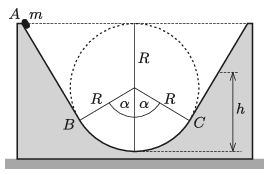 Problem P. 5251. (October 2020)
Problem P. 5251. (October 2020)
P. 5251. A small body of mass \(\displaystyle m\) is released from rest at point \(\displaystyle A\) of a fixed prism shown in the figure. The body slides frictionlessly along the straight slope on the left side and along the circular path of radius \(\displaystyle R\). The straight slope on the right is not frictionless, the coefficient of friction is \(\displaystyle \mu\).

\(\displaystyle a)\) What force is exerted by the body on the prism at the lowest point of the path?
\(\displaystyle b)\) What is the speed of the body at point \(\displaystyle C\)?
\(\displaystyle c)\) To what height \(\displaystyle h\) will the body go up?
Data: \(\displaystyle m =0.6\) kg, \(\displaystyle R = 30\) cm, \(\displaystyle \alpha = 60^\circ\), \(\displaystyle \mu = \frac12\tan\alpha\).
(5 pont)
Deadline expired on November 16, 2020.
Sorry, the solution is available only in Hungarian. Google translation
Megoldás. \(\displaystyle a)\) Jelöljük a keresett sebességet \(\displaystyle v\)-vel, és írjuk fel a munkatételt az \(\displaystyle A\) pont és a pálya legmélyebb pontja közötti mozgásra:
\(\displaystyle mg\cdot 2R=\frac{1}{2}mv^2,\)
vagyis
\(\displaystyle \frac{v^2}{R}=4g.\)
(Ez a mennyiség nem más, mint a test centripetális gyorsulása a pálya legmélyebb pontjánál.) A dinamika alaptörvénye szerint
\(\displaystyle N-mg=4mg,\)
azaz a hasábotot nyomó erő:
\(\displaystyle N=5mg=29{,}4~{\rm N}.\)
\(\displaystyle b)\) Jelöljük a kérdéses sebességet \(\displaystyle u\)-val, és írjuk fel a munkatételt az \(\displaystyle A\) és a \(\displaystyle C\) pont közötti mozgásra:
\(\displaystyle mg(R+R\cos\alpha)=\frac{mu^2}{2},\)
tehát
\(\displaystyle u=\sqrt{2g(R+R\cos\alpha)}=\sqrt{3Rg}=2{,}97~\frac{\rm m}{\rm s}\approx 3~\frac{\rm m}{\rm s}.\)
\(\displaystyle c)\) Legyen a súrlódásos szakasz hossza \(\displaystyle \ell\). Mivel a testre ható súrlódási erő \(\displaystyle S=mg\mu \cos\alpha=\frac{mg}{2}\sin\alpha\), a munkatétel az indulástól a megállásig:
\(\displaystyle mg\left(\frac32R-\ell\sin\alpha\right)- \frac{mg}{2}\ell\sin\alpha =0,\)
ahonnan \(\displaystyle \ell\sin\alpha=R\) következik. A kérdéses magasság tehát
\(\displaystyle h=R(1-\cos\alpha)+\ell\sin\alpha = R\left(1-\frac12\right)+R=\frac32R=45~\rm cm.\)
Statistics:
91 students sent a solution. 5 points: Antalóczy Szabolcs, Balogh Huba Kadosa, Bognár 171 András Károly, Bonifert Balázs, Csapó Tamás, Csonka Illés, Dobre Zsombor, Domján Dorina, Dóra Márton, Ferencz Kamilla, Gurzó József, Juhász Júlia, Kaltenecker Balázs Bence, Kertész Balázs, Koleszár Benedek, Koszta Benedek, Kovács Kinga, Kozaróczy Csaba, Köpenczei Csanád, Ludányi Levente, Mócza Tamás István, Mozolai Bende Bruno, Németh Kristóf, Perényi Barnabás, Répási Tamás, Ruzsa Bence, Sas 202 Mór, Schäffer Bálint, Schmercz Blanka, Somlán Gellért, Somogyi Boglárka Zsófia, Surányi Blanka, Szabó Márton, Szász Levente, Szirmai Dénes, Szoboszlai Szilveszter, Téglás Panna, Toronyi András, Tóth Ábel, Török 111 László, Török Dorka, Varga Vázsony, Viczián Máté. 4 points: 16 students. 3 points: 15 students. 2 points: 6 students. 1 point: 5 students. 0 point: 5 students. Unfair, not evaluated: 1 solutions.
Problems in Physics of KöMaL, October 2020
